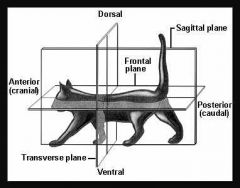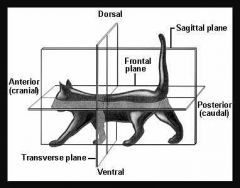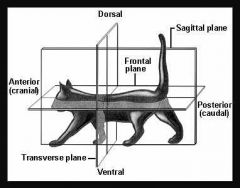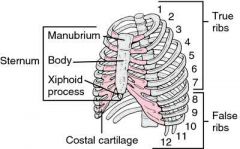![]()
![]()
![]()
Use LEFT and RIGHT arrow keys to navigate between flashcards;
Use UP and DOWN arrow keys to flip the card;
H to show hint;
A reads text to speech;
108 Cards in this Set
- Front
- Back
|
Anatomy |
Deals with the form and structure of the body and is parts- what things look like and where they're located |
|
|
Physiology |
Deals with the functions of the body and it's parts- how things work and what they do |
|
|
Microscopic anatomy |
Deals with structures so smallwe need a microscope to see them clearly- cells and tissues |
|
|
Macroscopic anatomy |
Also called gross anatomy, deals with body parts large enough to be seen with the unaided eye, such as organs, muscle, and bone |
|
|
Regional anatomy |
Regions of the body |
|
|
Systemic anatomy |
Systems of the body |
|
|
Skeletal body system |
Bones and joints |
|
|
Integumentary body system |
Skin, hair, nails, & hooves |
|
|
Nervous body system |
Central nervous system and peripheral nerves |
|
|
Cardiovascular body system |
Heart and blood vessels |
|
|
Respirator body system |
Lungs & air passageways |
|
|
Digestive body system |
Gastrointestinal tube and accessory digestive organs |
|
|
Muscular body system |
Skeletal, cardiac, and smooth muscle |
|
|
Sensory body system |
Organs of general and special sense |
|
|
Endocrine body system |
Endocrine glands and hormone |
|
|
Urinary body system |
Kidneys, ureters, urinary bladder, and uretha |
|
|
Reproductive body system |
Male and female reproductive structures |
|
|
Planes of reference |
Any of four basic imaginary slices through an animal body oriented at right angle to each other |
|
|
Sagittal plane |

Plane that runs the length of the body and divides it into left and right parts that are not necessarily equal halves |
|
|
Median plane |
A special kind of sagittal plane that runs down the center of the body lengthwise and divides it into equal left and right halves (mid sagittal plane) |
|
|
Transverse plane |

A plane across the body that divides it into cranial (head end) and caudal (tail end) parts that are not necessarily equal |
|
|
Dorsal plane |

A plane at right angle to the sagittal and transverse plane. Divides the body into dorsal (toward the animals back) and ventral (towards the animals belly) parts that are not necessarily equal |
|
|
Cranial |
Towards the head (cranium) |
|
|
Caudal |
Towards the tail (cauda) |
|
|
Xiphoid process |

The caudal end of the sternum (breast bone) |
|
|
Superior |
Used in place of cranial in humans |
|
|
Inferior |
Used in place of caudal in humans |
|
|
Rostral |
Towards the tip of the nose (rostrum) |
|
|
Dorsal |
Towards the back (top surface) of a standing animal |
|
|
Ventral |
Towards the belly (bottom surface) of a standing animal |
|
|
Posterior |
Takes the place of dorsal in humans |
|
|
Anterior |
Takes place of ventral in humans |
|
|
Medial |
Means towards the median plane (center line of body) |
|
|
Lateral |
Means away from the median plane |
|
|
Deep |
Towards the center of the body or a body part (internal) |
|
|
Superficial |
Towards the surface of the body or body part. (External) |
|
|
Proximal |
Used to describe positions only on extremities, such as leg, ears, tail, relative to the body. Proximal means towards the body |
|
|
Distal |
Used to describe positions only on extremities, such as legs, ears, tail, relative to the body. Distal means away from the body |
|
|
Carpus |
Proximal-Distal dividing line for the front leg is the proximal end of the carpus (Equivalent to our wrist) |
|
|
Tarsus |
The dividing line for the rear leg is the proximal end of the Tarsus (equivalent to our ankle ) |
|
|
Palmar surface |
The back surface of the front leg from the carpus distal is called the Palmar surface - like the palm of our hand |
|
|
Plantar surface |
The back of the hind leg from the Tarsus distally is called the plantar surface |
|
|
Bilateral symmetry |
Means that the left and right halves of an animals body are essentially mirror image of each other |
|
|
Gastrointestinal tract (GI) |
Stomach, small intestine and large intestine |
|
|
Dorsal body cavity |
Consists of two parts, cranial cavity in the skull and a long narrow spinal cavity running down the spine. |
|
|
Cranium |
The cranial cavity is also known as the cranium. Protects the brain |
|
|
Spinal canal |
Also known as spinal cavity. |
|
|
Ventral body cavity |
Contains most of the soft organs (viscera) |
|
|
Thorax |
Thin diaphragm muscle into the cranial thoracic cavity, also known as thorax or chest and the caudal abdominal cavity, also known as the abdomen |
|
|
Pleura |
All the organs in the thoracic cavity are covered by a thin membrane called pleura. |
|
|
Visceral layer |
The layer that covers the organs is called the visceral late of the pleura because it lies right of the viscera (the organs) |
|
|
Parietal layer |
The layer that lines the quilt thoracic cavity is called the parietal layer of pleura |
|
|
Inflammation |
When the pleural surfaces become thickened and roughed by inflammation. A condition called pleurisy or pleurisy |
|
|
Tissues |
When specialized cell groups form together |
|
|
Epithelial tissue |
Is composed entirely of cells, and is main jobs are to cover body surfaces, secrete meterials, and absorb materials |
|
|
Connective tissue |
Holds the body together |
|
|
Adipose tissue |
Commonly called fat tissue, very firm such as cartilage and bone |
|
|
Muscle tissue |
Moves the body inside and out. 3 types- skeletal muscle, cardiac muscle & smooth muscle |
|
|
Skeletal muscle |
Moves the bone of the skeleton and is under conscious nervous system control |
|
|
Cardiac muscle |
Makes up the heat and world "automatically" (no conscious effort required) |
|
|
Smooth muscle |
Found in internal organs such as the digestive tract and urinary bladder. Also works automatically |
|
|
Nervous tissue |
Transmits information around the body and controls body functions. |
|
|
Organs |
Made up of groups of tissues that work together for common purpose |
|
|
Systems |
Most complex level of body organization. Groups of organs that are involved in a common set of activities |
|
|
Digestive system |
Concerned with obtaining, digesting & absorbing nutrients to fuel the rest of the body |
|
|
Health |
State of normal anatomy and physiology |
|
|
Homeostasis |
Maintenence of a dynamic equilibrium in the body |
|
|
Equilibrium |
Refers to balance |
|
|
Polar |
Meaning they have sense of direction relative to surrounding structures |
|
|
Apical surface |
Faces the lumen or body cavity |
|
|
Basal surface |
Faces the underlying connective tissue |
|
|
Cell junctions |
The junctional attachments that connect epithelial cells |
|
|
Microvilli |
Epithelial cells that have irregular surfaces that are covered with fingerlike projections |
|
|
Celia |
Hairlike projections |
|
|
Simple epithelium |
Is a single layer of cells |
|
|
Stratified epithelium |
Multiple layers of epithelial cells |
|
|
Multicellular exorcize glands |
Majority of the glands present in most animals |
|
|
Endocrine glands |
Those that secrete their products directly into the blood and lymph vessels |
|
|
Collagenous fibers |
Found in tendons and ligaments |
|
|
Reticular fibers |
Found in highly cellular organs such as lymph nodes |
|
|
Elastic fibers |
Found in tissues that stretch such as vocal cords and skin |
|
|
Fixed cells |
Remain in connective tissue and include fibroblasts, fat cells and reticular cells |
|
|
Transient cells |
Wander in and out of the connective tissues as needed |
|
|
Dense and loose connective tissues |
Both embedded in a matrix of elastin and collagen |
|
|
Adipose tissue |
Embedded in a lipid matrix. They store fat and have wide distribution in organisms |
|
|
Cartilage cells |
Embedded in a matrix of collagen. Cartilage makes up most of the respiratory passages and is also found in ears |
|
|
Bone cells (osteocytes) |
Also embedded in a matrix of collagen and minerals and form the skeleton of an organism |
|
|
Blood |
Represents a unique type of connective tissue in that the cells aren't embedded in a non living matrix but are freely flowing through it, such as plasma |
|
|
Erythrocytes |
Red blood cells |
|
|
Leukocytes |
White blood cells |
|
|
Membranes |
Connective and epithelial tissues are linked to form structure called membranes |
|
|
Mucous membranes |
Line the organs of the reproductive, urinary and respiratory tract systems |
|
|
Lamina propria |
Loose connective tissue layer |
|
|
Submucosa |
Second connective tissue layer |
|
|
Serous membranes |
Line the organs within the thoracic, abdominal, and pelvic cavities |
|
|
Visceral layer |
The layer closest to the organ |
|
|
Parietal layer |
Layer closest to the body cavity |
|
|
Mesenteries |
The visceral layer of the serous membranes becomes merged to form supportive ligaments |
|
|
Cutaneous membranes |
Are also known as the integumentary, which is considered to be an organ system |
|
|
Synovial membranes |
Line the joint cavities and are composed only of loose connective and adipose tissue |
|
|
Synovial fluid |
Which reduces friction in the joint spaces |
|
|
Muscle tissues |
Consist of specialized cells that can be shortened to produce movement when stimulated |
|
|
Granulation tissues |
Composed of collagen fibers permeated with many capillaried, this protects the injured area from further damage |
|
|
Inflammation |
The bodies attempt to limit further damage |
|
|
Vasoconstriction |
The blood vessels narrow and cause a decrease in blood flow to the area |
|
|
Vasodilation |
Widening of the blood vessels |
|
|
First intention healing |
Where granulation tissue isn't formed and the wounded edges heal quickly |
|
|
Second intention healing |
Formation of granulation tissue |

